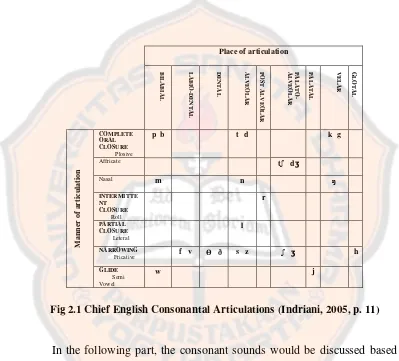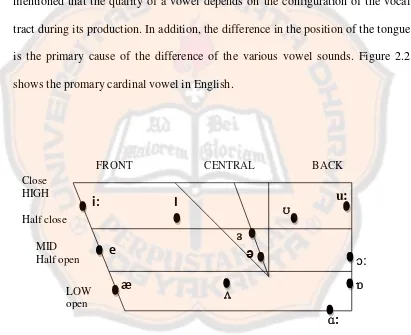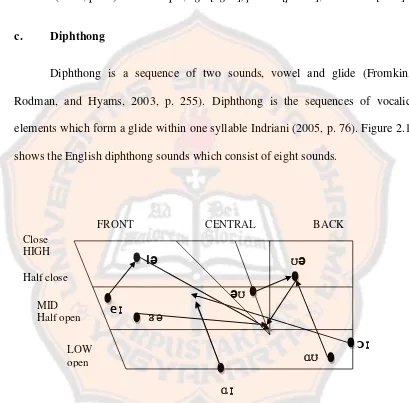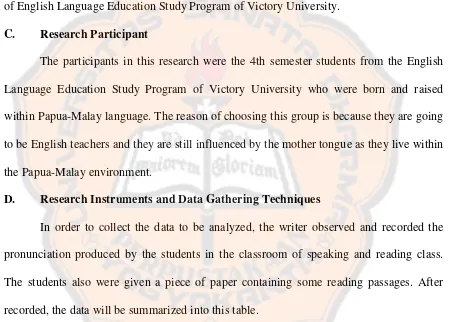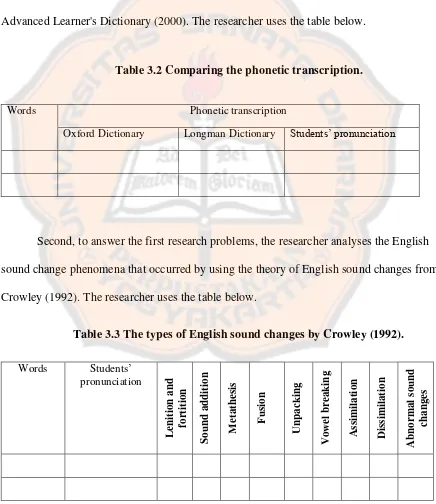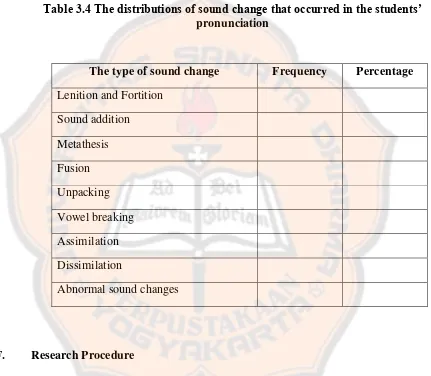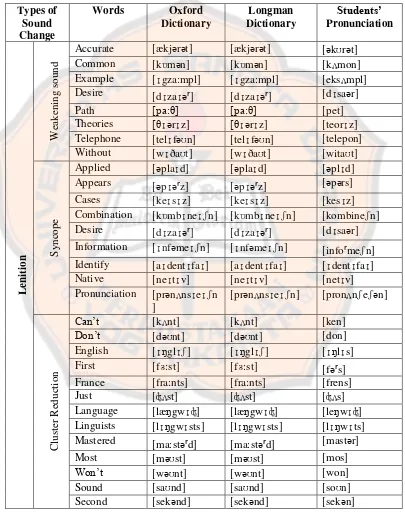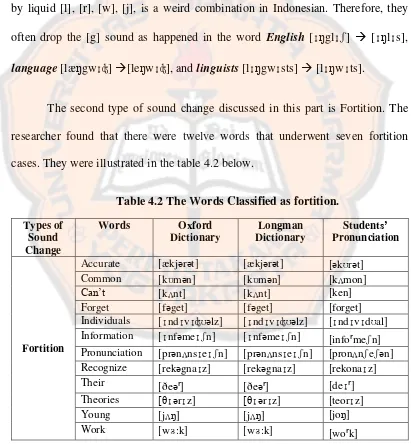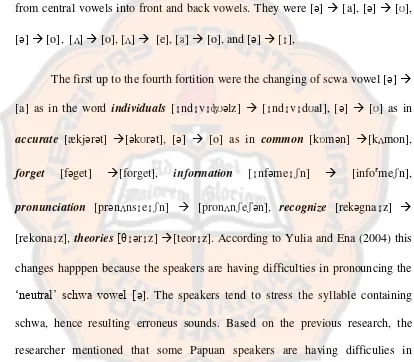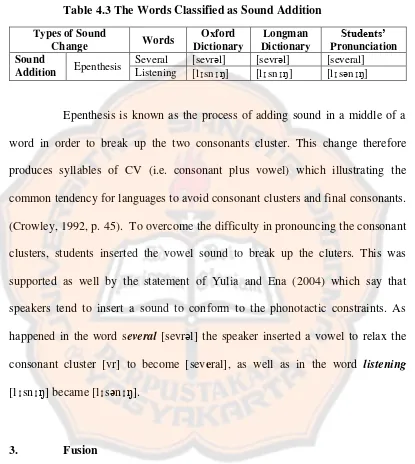vii ABSTRACT
Rahamitu, Engelbertha M. S. (2015). The English Sound Change of English Language Education Study Program Students of Victory University Sorong West Papua. Yogyakarta : Sanata Dharma University.
A mother tongue is the first language that people acquire from their family and environment. In order to broaden people’s communication, they learn another language. Some problems appear when people try to speak English as the second language but then they borrow the pattern from their mother tongue or as it called
‘negative transfer’. This causes the sound changes which become the researcher’s intention to conduct this research.
The research was intended to provide information about the English sound changes of the English Language Education Study Program students of Victory University whose first language is Papua-Malay dialect. It also studied the distribution of the sound change among the participants.
This research used mixed method research. The participants in this research were the 4th semester students of English Language Education Study Program of Victory University. There were fifteen students who took part in this
research.The researcher analyzed the sound change phenomenon in the students’ pronunciation. The students’ pronunciation was recorded by using audio recorder.
After recording, students’ pronunciation was translated into the phonetic transcription and was compared with the phonetics transcription based on Oxford Dictionary and Longman Dictionary.
The researcher found seven out of nine types of sound change classified by Crowley (1992). They were lenition and fortition, sound addition, fusion, unpacking, vowel breaking, assimilation, and abnormal change. The distribution showed that lenition and fortition were the most frequent sound change occured in the students’ pronunciation and followed by abnormal change, assimilation, sound addition, fusion, unpacking and vowel breaking. In addition, the researcher also offered recommendation for the teachers and lecturers, ELESP students of Victory University, and future researcher who is interested in this topic.
viii
ABSTRAK
Rahamitu, Engelbertha M. S. (2015). The English Sound Change of English Language Education Study Program Students of Victory University Sorong West Papua. Yogyakarta : Universitas Sanata Dharma.
Bahasa ibu adalah bahasa pertama yang diperoleh seseorang dari keluarga dan lingkungannya. Dengan tujuan memperluas komunikasi, seseorang belajar bahasa yang lain. Permasalahan terjadi ketika seseorang berusaha untuk berbicara bahasa Inggris sebagai bahasa kedua, namun ia membawa struktur bahasa dari bahasa asalnya atau yang disebut dengan ‘transfer negatif’. Hal ini menyebabkan perubahan bunyi yang kemudian menjadi tujuan peneliti untuk melakukan penelitian ini.
Penelitian ini bertujuan untuk menyediakan informasi terkait perubahan bunyi dari mahasiswa pendidikan bahasa Inggris universitas Victory yang memiliki bahasa pertama Papua-Malay. Penelitian ini juga mempelajari pendistribusian perubahan bunyi tersebut diantara partisipan.
Penelitian ini menggunakan metode penelitian campuran. Partisipan di dalam penelitian ini merupakan mahasiswa semester 4 dari Pendidikan Bahasa Inggris Universitas Victory Sorong. Terdapat lima belas mahasiswa yang terlibat dalam peneltian ini.Peneliti menganalisa fenomena perubahan bunyi yang terjadi pada mahasiswa. Pelafalan mahasiswa direkam dengan menggunakan media perekam suara. Setelah proses rekaman, hasil pelafalan mahasiswa diterjemahkan kedalam transkrip fonetik dan dibandingkan dengan transkrip fonetik yang terdapat pada kamus Oxford dan Longman.
Peneliti menemukan tujuh dari sembilan tipe perubahan bunyi seperti yang diklasifikasikan oleh (Crowley, 1992). Perubahan bunyi tersebut adalah lenition and fortition, sound addition, fusion, unpacking, vowel breaking, assimilation, dan abnormal change. Pembagian menunjukan bahwa lenition and fortition merupakan tipe perubahan bunyi yang paling sering dilakukan mahasiswa. Selanjutnya diikuti oleh abnormal change, assimilation, sound addition, fusion, unpacking dan vowel breaking. Sebagai tambahan, peliti juga menawarkan rekomendasi kepada guru dan dosen, mahasiswa Pendidikan Bahasa Inggris di Universitas Victory dan peneliti dikemudian hari yang tertarik pada topik ini.
THE ENGLISH SOUND CHANGE OF ENGLISH LANGUAGE
EDUCATION STUDY PROGRAM STUDENTS OF VICTORY
UNIVERSITY SORONG WEST PAPUA
A SARJANA PENDIDIKAN THESIS
Presented as Partial Fulfilment of the Requirements to Obtain the Sarjana Pendidikan Degree
in English Language Education
By
Engelbertha Maria Serviam Rahamitu Student Number: 111214175
ENGLISH LANGUAGE EDUCATION STUDY PROGRAM DEPARTMENT OF LANGUAGE AND ARTS EDUCATION FACULTY OF TEACHERS TRAINING AND EDUCATION
SANATA DHARMA UNIVERSITY YOGYAKARTA
i
THE ENGLISH SOUND CHANGE OF ENGLISH LANGUAGE
EDUCATION STUDY PROGRAM STUDENTS OF VICTORY
UNIVERSITY SORONG WEST PAPUA
A SARJANA PENDIDIKAN THESIS
Presented as Partial Fulfilment of the Requirements to Obtain the Sarjana Pendidikan Degree
in English Language Education
By
Engelbertha Maria Serviam Rahamitu Student Number: 111214175
ENGLISH LANGUAGE EDUCATION STUDY PROGRAM DEPARTMENT OF LANGUAGE AND ARTS EDUCATION FACULTY OF TEACHERS TRAINING AND EDUCATION
SANATA DHARMA UNIVERSITY YOGYAKARTA
iv
I have become sounding brass or a clanging cymbal. If I have the gift of prophecy,
and know all mysteries and all knowledge; And if I have all faith so as to remove mountains,
BUT DON’T HAVE LOVE, I am nothing. (1 Corinthians 13;1-2)
Dedicated to:
My Dad
v
STATEMENT OF WORK’S ORIGINALITY
I honestly declare that this thesis, which I have written, does not contain the work or parts of the work of other people, except those cited in the quotations and the references, as a scientific paper should.
Yogyakarta, 10 August 2015 The Writer
vi
LEMBAR PERNYATAAN PERSETUJUAN
PUBLIKASI KARYA ILMIAH UNTUK KEPENTINGAN AKADEMIK
Yang bertandatangan di bawah ini, saya mahasiswa Universitas Sanata Dharma:
Nama : Engelbertha Maria Serviam Rahamitu
NomorMahasiswa : 111214175
Demi pengembangan ilmu pengetahuan, saya memberikan kepada Perpustakaan Universitas Sanata Dharma karya ilmiah saya yang berjudul:
THE ENGLISH SOUND CHANGE OF ENGLISH LANGUAGE EDUCATION STUDY PROGRAM STUDENTS OF VICTORY UNIVERSITY SORONG WEST
PAPUA
Beserta perangkat yang diperlukan (bila ada). Dengan demikian saya memberikan kepada PerpustakaanSanata Dharma hak untuk menyimpan, mengalihkan dalam bentuk media lain, mengelolanya dalam bentuk pangkalan data, mendistribusikanya secara terbatas, dan mempublikasikannya di internet atau media lain untuk kepentingan akademis tanpa perlu minta ijin dari saya maupun memberikan royalty kepada saya selama tetap mencantumkan nama saya sebagai penulis.
Demikian pernyataan ini saya buat dengan sebenarnya.
Dibuat di Yogyakarta
Pada Tanggal: 10 Agustus 2015
Yang menyatakan
vii ABSTRACT
Rahamitu, Engelbertha M. S. (2015). The English Sound Change of English Language Education Study Program Students of Victory University Sorong West Papua. Yogyakarta : Sanata Dharma University.
A mother tongue is the first language that people acquire from their family and environment. In order to broaden people’s communication, they learn another language. Some problems appear when people try to speak English as the second language but then they borrow the pattern from their mother tongue or as it called
‘negative transfer’. This causes the sound changes which become the researcher’s intention to conduct this research.
The research was intended to provide information about the English sound changes of the English Language Education Study Program students of Victory University whose first language is Papua-Malay dialect. It also studied the distribution of the sound change among the participants.
This research used mixed method research. The participants in this research were the 4th semester students of English Language Education Study Program of Victory University. There were fifteen students who took part in this
research.The researcher analyzed the sound change phenomenon in the students’ pronunciation. The students’ pronunciation was recorded by using audio recorder.
After recording, students’ pronunciation was translated into the phonetic transcription and was compared with the phonetics transcription based on Oxford Dictionary and Longman Dictionary.
The researcher found seven out of nine types of sound change classified by Crowley (1992). They were lenition and fortition, sound addition, fusion, unpacking, vowel breaking, assimilation, and abnormal change. The distribution showed that lenition and fortition were the most frequent sound change occured in the students’ pronunciation and followed by abnormal change, assimilation, sound addition, fusion, unpacking and vowel breaking. In addition, the researcher also offered recommendation for the teachers and lecturers, ELESP students of Victory University, and future researcher who is interested in this topic.
viii
ABSTRAK
Rahamitu, Engelbertha M. S. (2015). The English Sound Change of English Language Education Study Program Students of Victory University Sorong West Papua. Yogyakarta : Universitas Sanata Dharma.
Bahasa ibu adalah bahasa pertama yang diperoleh seseorang dari keluarga dan lingkungannya. Dengan tujuan memperluas komunikasi, seseorang belajar bahasa yang lain. Permasalahan terjadi ketika seseorang berusaha untuk berbicara bahasa Inggris sebagai bahasa kedua, namun ia membawa struktur bahasa dari bahasa asalnya atau yang disebut dengan ‘transfer negatif’. Hal ini menyebabkan perubahan bunyi yang kemudian menjadi tujuan peneliti untuk melakukan penelitian ini.
Penelitian ini bertujuan untuk menyediakan informasi terkait perubahan bunyi dari mahasiswa pendidikan bahasa Inggris universitas Victory yang memiliki bahasa pertama Papua-Malay. Penelitian ini juga mempelajari pendistribusian perubahan bunyi tersebut diantara partisipan.
Penelitian ini menggunakan metode penelitian campuran. Partisipan di dalam penelitian ini merupakan mahasiswa semester 4 dari Pendidikan Bahasa Inggris Universitas Victory Sorong. Terdapat lima belas mahasiswa yang terlibat dalam peneltian ini.Peneliti menganalisa fenomena perubahan bunyi yang terjadi pada mahasiswa. Pelafalan mahasiswa direkam dengan menggunakan media perekam suara. Setelah proses rekaman, hasil pelafalan mahasiswa diterjemahkan kedalam transkrip fonetik dan dibandingkan dengan transkrip fonetik yang terdapat pada kamus Oxford dan Longman.
Peneliti menemukan tujuh dari sembilan tipe perubahan bunyi seperti yang diklasifikasikan oleh (Crowley, 1992). Perubahan bunyi tersebut adalah lenition and fortition, sound addition, fusion, unpacking, vowel breaking, assimilation, dan abnormal change. Pembagian menunjukan bahwa lenition and fortition merupakan tipe perubahan bunyi yang paling sering dilakukan mahasiswa. Selanjutnya diikuti oleh abnormal change, assimilation, sound addition, fusion, unpacking dan vowel breaking. Sebagai tambahan, peliti juga menawarkan rekomendasi kepada guru dan dosen, mahasiswa Pendidikan Bahasa Inggris di Universitas Victory dan peneliti dikemudian hari yang tertarik pada topik ini.
ix
ACKNOWLEDMENTS
I would like to thank everyone, who either directly or indirectly, contributed
a lot to the accomplishment of this thesis. I would like to express my greatest
gratitude to Jesus Christ for always loving and stenghthening me during the hardest
time of my study. I realize that I am nothing without Him.
I am most grateful to Fx. Ouda Teda Ena, M.Pd., Ed.D., my major
sponsor, who has given me his patient guidence and his encouragement. My
profound gratitude also goes to him that in spite of his duty, he was always ready
to help me in completing this thesis.
I would like to thank Bruder Filianus Nasu Rusik who helped me a great
deal in finishing this study. I thank him because of his valuable time spent to give
me references, comments and supports as well.
Next appreciation goes to Orpa Elsi Waromi, S. Pd. and Marje E. Holle,
S.Pd., M.M for their kindness to let me conduct this research in Victory University,
and also Lulu Jola Wattimena, S. Pd., the lecturer in Victory University for her
valuable time in the classroom given to me to conduct the research. My gratitude is
extended also to the 4th semester students of the English Language Education Study
Program of Victory University who have become participants of this study and for
their cooperation and willingness to read the passage and share their experiences.
I am also grateful to my beloved family for their assistence that enabled me
to stand and face every obstacle in the hardest time of my study. I also thank my
Mom and my big brother Rio for their sacrifices to work hard to provide me with
everything that I need to study. My special gratitude also goes to my dearest Daddy
for the endless love, prayers, and supports that wonderfully strengthen me every
day to finish my study.
x
My sincere gratitude also goes to Kementrian Pendidikan dan Kebudayaan Republik Indonesia for their most helpful program Beasiswa Unggulan that paid my tuition for the past 4 years.
I would like to thank my dearest friends Marlin Bre, Faradita Shabrina,
B. Gracia, PBI 2011 Class C, and SMANTI Sorong 2010, for their most
valuable support in various ways that helped me to finish this thesis happy and alive. They taught me the attitude of “piye carane isa!”, and never give up.
My special thanks go to UKM PSM Cantus Firmus and all of the greatly
talented people there for helping me in the process of finding who I am and
exploring the best of me. Their readiness to cheer me up has always been a big
support to finish my study and be a better person.
I sincerely express my special thanks to Ferdinandus Giovani Yamlean,
S.T. for being my biggest supporter. His love, attention, patient, prayer, and
support has motivated me to finish my study whole-heartedly.
Last but not least, I would also like to express my gratitude to those whose
names I cannot mention here, but have given me a hand in finishing this thesis.
May God bless all of you.
Engelbertha Maria Serviam Rahamitu
xi
TABLE OF CONTENTS
Page
TILTE PAGE ... i
APPROVAL PAGE ... ii
STATEMENT OF WORK’S ORIGINALITY ... v
PERNYATAAN PERSETUJUAN PUBLIKASI ... vi
ABSTRACT ... vii
1) Articulatory Simplification ... 8
2) Regularization ... 9
3) Language Contact ... 9
xii
3. English Sound Production ... 14
xiii
D. Research Instruments and Data Gathering Technique ... 34
E. Data Analysis Techniques ... 35
F. Research Produre ... 36
CHAPTER IV. RESEARCH RESULTS AND DISCUSSION A. Types of Participants’ Sound Change ... 39
1. Lenition and Fortition ... 39
B. The distribution of The Sound Change ... 56
CHAPTER V. CONCLUSIONS AND RECOMMENDATIONS A. Conclusions ... 61
B. Recommendations ... 62
1. For English Teachers or Lecturers ... 62
2. For Students of ELESP Victory University ... 62
3. For Future Researchers ... 63
REFERENCES ... 64
xiv
LIST OF TABLES
Table Page
3.1 The Phonetic Transcription of Students’ Pronunciation ... 34
3.2 Comparing the Phonetic Transcription ... 35
3.3 The Types of English Sound Changes by Crowley (1992) ... 35
3.4 The Distributions of Sound Change Occurred in the Students’ Pronunciation ... 36
4.1 The Words Classified as Lenition ... 40
4.2 The Words Classified as Fortition ... 44
4.3 The Words Classified as Sound Addition ... 47
4. 4 The Words Classified as Fusion ... 48
4. 5 The Words Classified as Unpacking ... 49
4.6 The Words Classified as Vowel Breaking ... 50
4.7 The Words Classifies as Assimilation ... 51
4.8 The Words Classified as Abnormal Sound Change ... 53
xv
LIST OF FIGURES
Figure Page
2.1 Consonant Articulation (Indriani, 2005) ... 15
2.2 English Vowel Sounds (Indriani, 2001) ... 23
2.3 English Diphthong Sounds (Indriani, 2001) ... 27
xvi
LIST OF APPENDICES
Apendix Page
APPENDIX A Permission Letter ... 67
APPENDIX B Sample of The Passage ... 69
APPENDIX C The Comparison of Phonetic Transcription ... 71
APPENDIX D Students’ Pronunciation ... 74
1
CHAPTER 1
INTRODUCTION
This chapter provides general introduction to the research. There are six
sections that will be discussed. They are the background of the study, problem
formulation, problem limitation, research objectives, research benefits, and
definition of terms.
A. Research Background
A mother tongue is the first language that people acquire from the family
and environment. It has directly structured in mind because people use it all the
time. This repetition makes people strongly get used to it. Moreover, when people
learn a second language in this case is English, there is something happen in the
brain when it has to transfer the second language in to the first language to
understand it. The problems appear when people try to speak English as the
second language but then they borrow the pattern from their mother tongue.
Wilkins (1972) defines the language transfers as follows:
“When learning a foreign language an individual already knows his mother
tongue, and it is this which he attempts to transfer. The transfer may prove to be justified because the structure of the two languages is similar – in that case we get
“Positive transfer” or “facilitation” – or it may prove unjustified because the structure of the two languages are different – in that case we get “negative
transfer” or“interference” (p. 199)
This statement clarifies some problems occured in people’s
pronounciation. That is because of the ‘negative transfer’. Some people with
language. Some of the problems occur in the English pronunciation. When people
found any similar elements from the first language to the second language, they
may be able to pronounce it. However, if there are different elements people may
mispronounce the words and make any changes in the sound.
This is also happen in the process of learning English as a second language
of some university students in English Language Education Study Program whose
first language is Papua-Malay Dialect. The writer found that the students often
mispronounce the words and tend to replace the sound with a more familiar sound
which is easier for them to pronounce. This substitution was once explained by
Crystal (1991) that “Substitution refers to the process or result of replacing one
item by another at a particular place.” (p. 335) In this study, the students made the
substitutions as the result of simplification of the sound that was easier for them to
pronounce certain English sounds. For example, the word they [ðeI] will be
pronounced as [deI] the same case happen with the words that have a cluster of
consonant like text [tekst] will be pronounced as [tek] or just [teks].
This kind of changes or substitution has motivated the writer to observe
and do the research on it which took a specific background of mother tongue
Papua–Malay dialect. Many students of English Language Education Study
Program are from the background of L1 that is Papua-Malay especially in some
universities in Papua. As they are trying to be a good English teacher with a good
pronunciation of English, they have to face this kind of changes. This becomes
really important for English teachers to-be to consider this sound changes in order
language with a good English pronunciation. The focus of this research is the
sound change of the students of English Language Education Study Program
whose first language is Papua-Malay dialect.
B. Research Problems
In conducting this research the writer focuses on these questions to be
answered:
1. What are the types of English sound change of the students of ELESP
of Victory University whose first language is Papua-Malay dialect?
2. What is the distribution of the sound change among the students of
ELESP of Victory University whose first languange is Papua-malay
dialect?
In order to answer these questions, the writer conducted a survey at
Victory University in Sorong, West Papua, specifically the English Language
Education Study Program. The writer chose the sample from the 4st semester
students in a speaking class using intended sample.
C. Problem Limitation
This research was limited on the English sound change in the
pronunciation of the students of ELESP of Victory University whose first
language is Papua-Malay dialect. The writer intended to know and dig out the
phenomena of sound change that occurred on students’ pronunciation.
It would not include the discussion of pitch, stress, intonation, and
the students because the focus was only to provide information related to the
sound change of the students’ pronunciation.
D. Research Objectives
The objectives of this study were to find out the types of English sound
changes of the students of English Department whose first language is
Papua-Malay and the distribution of the sound change among participants.
E. The Benefits
The results of this study are expected to be beneficial for further
development related to this topic. Moreover, there are some benefits aimed at the
teachers and lecturers in English Department of Victory University or commonly
in Sorong West Papua, students of the English Department, and future
researchers. For teachers and lecturers in English Department of Victory
University or commonly in Sorong West Papua hopefully this study will help the
them to analyze the sound change that occurred on the students’ pronunciation, to
know how why students tend to do the mispronunciation of certain English
sounds, and to know how to deal with this changes when it occurs to the students.
For students of ELESP at Victory University, hopefully this study will
help them to improve their English pronunciation and minimize their difficulties
in pronouncing English sounds. Moreover, to help them knowing how to teach the
correct English pronunciation to their own students as they are going to be
For future researchers, hopefully this study can provide several new
significant ideas and data to be investigated further at the other fields or language
backgrounds.
F. Definition of Terms
This study used several terms to discuss the topic. Therefore, it is
important to give appropriate information about the definition that the researcher
mentioned in this study to avoid misunderstanding and to lead readers to a better
understanding on the topic being discussed. The definition terms used in this
thesis are:
1. Language Change
Croft (2000, p. 1) mentiones that language change is a historical
phenomenon, which becomes a thing to be dealt with historical linguistics.
Historical linguistics is sometimes called diachronic linguistics which is more
concerned with changes in languages over time and synchronic linguistics that
deals with languages at a single period of time Campbell (2004, p. 4). This
research use a synchronic perspective as it is conducted to describe the actual
pronunciation of present-day English spoken in a particular speech community.
2. Phonological Change
Phonological change refers to any change in the sound system Fasold and
Linton (2006, p. 281). Moreover, Fromkin, Rodman and Hyams (2003, p. 504)
3. Negative Transfer
In the process of transfering language from source language to the target
language, an individual will experience either positive of negative transfer. According to
Wilkins (1992), the transfer may prove unjustified because the structure of the two
languages are different –in that case we get “negative transfer” or “interference” (p. 199)
4. English Sound Change
Sound change is a change in the way members of a speech community
pronounce particular sounds. Sound changes result in phonological changes
Fasold and Linton (2006, p. 285). In this research, sound change refers to the
change of the sounds produced by some English department students as the
speech community with the background mother tongue is Papua-Malay Dialect.
5. Papua-Malay Dialect
Papuan Malay is a Malay–based language spoken in the Western part of
Papuan Island, Indonesia. It is one of the Austronesia languages of New Guinea
(Foley, 1976). In the past, it was a pidgin used as a lingua franca along the coastal
areas, where there was a lot of trade between the people from the island and
seafaring Malay traders from the west (Roosman, 1982, p. 95). During the time
the island was a colony of the Netherlands, it was used by missionaries to spread
the Scriptures of God among Papuan people, especially among those living in the
coastal areas in the North. It was at the time also enforced through education and
administration Adelaar and Prentice (1996). At this moment, Papuan Malay
becomes the mother tongue of the younger generations of the Papuan, as well as
7
CHAPTER II
REVIEW OF RELATED LITERATURE
This chapter aims to discuss the fundamental theories related to this
research. There are two elements discussed in this chapter; the theoretical
description and the theoretical framework.
A. Theoretical Description
The theoretical description involves the discussion about language change,
English sound change, and English sound production.
1. Language Change
All physical aspects of the universe and all aspects of human life are
subject to change, and languages are no exception Schendl (2001, p. 3). Language
changes also because they are used by human beings not machines. Human being
shared common physiological and cognitive characteristics, but members of a
speech community differ slightly in their knowledge and use of their shared
language Fasold and Linton (2006, p. 277). Different regions, social classes and
even generations will create a different use of a language. Moreover, Croft (2000,
p. 1) also says that language change is a historical phenomenon, which becomes a
thing to be dealt with historical linguistics. Historical linguistics is sometimes
called diachronic linguistics which is more concerned with changes in languages
over time and synchronic linguistics that deals with languages at a single period of
time Campbell (2004, p. 4). This research used a synchronic perspective as it was
particular speech community. These explanations below are the causes of
language change and the types of language change.
a. The Causes of Language Change
As mentioned before that languages change because they are used by
human beings not machines, it explains that as long as human beings exist the
language will keep changing as human are growing with many supporting factors
not stable like a machine. Campbell (2004, p. 316) mentioned that the internal
causes include the physical and psychological factor. The physical factor is for
example, the physiology of human speech organs. The psychological or cognitive
factor involves the perception, processing and learning of language. While, the
external causes involve factors such as expressive uses of language, positive and
negative social evaluations (prestige, stigma), the effects of literacy, prescriptive
grammar, educational policies, political degree, language planning, language
contact, and so on.
Related to the theory, Fasold and Linton (2006, p. 277) state that the
language change is motivated by the physiological, cognitive, and social forces
which can be attributed to articulatory simplification, regularization, and contact
between the languages. They are explained as follow.
1) Articulatory Simplification
Fasold and Linton (2006, p. 277) express that many changes in the
phonology of a language are motivated by the physiological goal of enhancing the
ease of articulation. It can be inferred that some people “simplify” the mechanism
52) states that a particular sound may not exist in the mother tongue. Therefore,
some non-native English speaker may substitute the nearest equivalence that the
speaker knows.
2) Regularization
A regular pattern is easier to learn than a pattern with lots of exception.
Children acquiring their native languages prefer regular pattern too, and over time
languages tend to erase irregularities Fasold and Linton (2006, p. 278).
3) Language Contact
One of the main reasons why languages change is because they come into
contact with other languages Schendl (2001, p. 55). It means, the contact of two
speakers may lead to the language change. According to Fasold and Linton (2006,
p. 278), language change is a result of contacts between speakers of different
languages.
b. Types of Language Change
According to Fasold and Linton (2006) there are four types of language
change, namely, morphological change, syntactic change, semantic change, and
1) Morphological Change
Morphological change refers to any change in the morphophonemic
system (the morphemes and their phonemic representation) of a language Fasold
and Linton (2006, p. 283).
2) Syntactic Change
Syntactic change refers to change in the grammatical system of a language
Fasold and Linton (2006, p. 284). Murray (1996, p. 337) states that syntactic
changes involve modifications to phrase structure rules or transformations.
Referring to those statements, syntactic change can be defined as the change of
the grammar and structure of the sentences.
3) Semantic Change
Semantic change is mainly concerned with change in the meanings of
words (Fasold and Linton, 2006, p. 284). Therefore, when the meaning itself
changes, it is probable for a word to have some meaning variations. Murray
(1996, p. 344) defines semantic change as the changes in word meaning and it
does take place in all languages. Campbell (2004, p. 252) also states that semantic
change is the change in meaning and vocabulary. Schendl (2001, p. 29) states that
semantic changes trigger the variety of language meaning. That is why people
4) Phonological Change
Phonological change focuses on the sound change. Phonological change
refers to any change in the sound system Fasold and Linton (2006, p. 281).
Murray (1996, p. 318) in his book Historical Linguistics: The Study of Language Change stated that most sound changes begin as subtle alterations in the sound pattern of a language in particular phonetic environments. That is why the changes
of sound of certain language including English occur slightly.
2. English Sound Change
Sound change is a change in the way members of a speech community
pronounce particular sounds. Sound changes result in phonological changes
Fasold and Linton (2006, p. 285). In this research, sound change refers to the
change of the sounds produced by some English department students as the
speech community with the background mother tongue is Papuan-Malay Dialect.
Crowley (1992) classifies types of sound change into nine catogories i.e lenition
and fortition, sound addition, metathesis, fusion, unpacking, vowel breaking,
assimilation, dissimilation, and abnormal sound changes (p. 39-59). Each type of
sound changes will be described below.
a. Types of Sound Change
The sounds of a language can change in a variety of ways, according to
Crowley (1992, p. 39-59) there are nine kinds of attested sound changes in the
1) Lenition and Fortition
Lenition refers to the weakening of sound such as devoicing and changes
from stronger sounds to the weaker ones. Lenition includes aphaeresis or the loss
of initial consonant, apocope or the loss of final vowels, and syncope, which is the
loss of medial vowels. It also includes cluster reduction, which refers to deletion
of one or more consonants, and haplology or the loss of an entire syllable in a
word. On the contrary, fortition refers to sound changes from weaker to stronger
sounds, such as semi-vowels into consonants (Crowley, 1992, p. 39-43).
2) Sound Addition
Sound addition includes excrescence, ephenthesis, and prothesis.
Excrescence refers to the process by which a consonant is added between two
other consonants in a word. Meanwhile, ephenthesis and prothesis refer to the
addition of vowel in the middle of a word to break two consonants and the
addition of sound at the beginning of a word respectively (Crowley, 1992, p.
43-45).
3) Metathesis
Metathesis is another type of sound change but it is quite uncommon. It
refers to a change in the order of the sounds (Crowley, 1992, p. 45). Fasold and
Linton (2006, p. 293) call it as a process when sometimes the positions of sounds
are transposed. For example, Old English hros, brid, thurh, thridda, wyrhta
4) Fusion
It refers to the blending of two separate sounds to become a single sound
and the resulting single sound carries some of the phonetic features of both of the
original sound (Crowley, 1992, p. 46).
5) Unpacking
Unpacking is a phonetic process that is the opposite of phonetic fusion.
From a single original sound, a sequence of two sounds may develop, each with
some of the feature of the original sound. (Crowley, 1992, p. 48).
6) Vowel Breaking
Vowel breaking is fairly common in the languages of the world. The
process refers to the change of a single vowel to become a diphthong, with the
original vowel remaining the same, but with a glide of some kind being added
either before or after it. (Crowley, 1992, p . 49) .
7) Assimilation
Many sound changes can be viewed as being due to the influence of one
sound upon another. This influence that causes one sound to change so that the
two sounds end up being more similar to each other in some way is called
8) Dissimilation
Dissimilation process is precisely the opposite of assimilation process.
Instead of making two sounds more like each other, this process means that one
sound changes to become less like some other nearby sound. Therefore, it reduces
the number of shared phonetic features between two sounds. (Crowley, 1992, p.
56).
9) Abnormal Sound Changes
Sometimes an individual sound has changed in a rather unusual way.
Abnormal sound changes are the sound changes that would appear, at first glance,
to be abnormal. In the sense that they do not obviously fit into any of the
categories that have mentioned above Crowley (1992).
3. English Sound Production
There are three parts that will be discussed as the English sound
production in this section. They are the English consonant, English vowels, and
diphthongs.
a. Consonant Sounds
Consonant is a speech sound which typically occurs at the margins of the
syllable (Collins and Mees, 2003, p. 72). It exists before or after a vowel or
diphthong to form a syllable. Consonant are produced with some restriction or
closure in the vocal tract that impedes the flow of air from lungs Fromkin,
consonants in English, namely, [p], [b], [t], [d], [k], [g], [f], [v], [s], [z], [ ʃ], [ʒ], [tʃ], [dʒ], [ө], [ð], [m], [n], [ŋ], [h], [l], [r], [w], [j] (p. 8). Figure 2.1 shows the articulation of the English consonant sounds.
Fig 2.1 Chief English Consonantal Articulations (Indriani, 2005, p. 11)
In the following part, the consonant sounds would be discussed based on
the place of articulation and the manner of articulation. Here are the details of the
English consonant sounds.
1) Bilabial Plosives [p,b]
[p] and [b] are two sounds of the English consonants. According to Fromkin, Rodman, and Hyams (2003), based on the place of the articulation, [p] and [b] sounds are articulated by bringing both lips together which is called bilabials (p. 242). Meanwhile, based on the manner of the articulation, the sound
[p] and [b] are called plosives or nonnasal, or oral, stops because when we produce these sounds, the air that is blocked in the mouth explodes when the
closure is released (Fromkin, Rodman, and Hyams, 2003, p. 247). For example,
pig [pɪg] and book [bʊk].
2) Alveolar Plosives [t,d]
Fromkin, Rodman, and Hyams (2003) explain that these sounds are called
plosives or nonnasal, or oral, stops which are produced by blocking the air in the
mouth and exploding when the closure is released (p. 247). In addtion he states
that based on the place of the articulation, [t] and [d] sounds are called alveolar in which these sounds are produced by raising the front part of the tongue to the
alveolar ridge (Fromkin, Rodman, and Hyams, 2003, p. 242). For example, time [taɪm], take [teɪk], and day [deɪ].
3) Velar Plosives [k,g]
Fromkin, Rodman, and Hyams (2003) state that based on the place of the
articulation, [k] and [g] sounds are called velar in which these sounds are produced by raising the back of the tongue to the soft palate or velum (p. 243).
Meanwhile, based on the manner of the articulation [k] and [g] sounds are called plosives because these sounds are produced by blocking the air in the mouth and
exploding when the closure is released (Fromkin, Rodman, and Hyams, 2003, p.
4) Palato-alveolar Affricates [tʃ,dʒ]
According to Indriani (2001), based on the place of the articulation [tʃ] and [dʒ] sounds are called palato-alveolar because to produce these sounds, the blade, or the tip and blade, of the tongue articulate with the alveolar ridge and there is at
the same time a raising of the front of the tongue towards the hard palate (p. 9).
For example, choice [tʃᴐɪs], cheap [tʃi:p], joke [dʒəʊk], and subject [səbdʒekt]. In addition, Fromkin, Rodman, and Hyams (2003) state that based on the manner of
the articulation, [tʃ] and [dʒ] include as affricates sounds bacause these sounds are produced by a stop closure followed immediately by a gradual release of the
closure that produces an effect characteristic of a fricative (p. 248).
5) Labio-dental Fricatives [f,v]
According to Fromkin, Rodman, and Hyams (2003), [f] and [v] sounds are called labiodentals in which to produce these sounds, we have to use our lips by
touching the bottom lip to the upper teeth. Labio refers to lips and dental refers to
teeth (p. 242). In addition, he states that based on the manner of the articulation,
these sounds are also called fricatives because to produce these sounds, the
airflow is so severely obstructed that it causes friction (Fromkin, Rodman, and
6) Dental Fricatives [ө,ð]
According to Fromkin, Rodman, and Hyams (2003), [ө] and [ð] sounds are called interdental because these sounds are formed with insert the tongue tip
between the upper and lower teeth and block the airstream and have the air push
through the narrow opening (p. 242). In addition, he states that based on the
manner of the articultion, these sounds are include as fricatives sounds. It is
because to produce these sounds, the airflow is so severely obstructed that it
causes friction (Fromkin, Rodman, and Hyams, 2003, p. 248). For example, thin [өɪn], healthy [helөi], the [ðə], and with [wɪð].
7) Alveolar Fricatives [s,z]
According to Fromkin (2000), based on the place of the articulation,
alveolar sound such as [s] and [z] are articulated by raising the front part of the tongue to the alveolar ridge (p. 242). In addition, based on the manner of the
articultion, these sounds are include as fricatives sounds because to produce these
sounds, the airflow is so severely obstructed that it causes friction (Fromkin,
Rodman, and Hyams, 2003, p. 248). For example, sing [sɪŋ], ask [ :sk], and does [dʌz].
8) Palato – alveolar Fricative [ʃ,ʒ]
According to Indriani (2001), based on the place of the articulation [ʃ] and
[ʒ] sounds are called palato-alveolar because to produce these sounds, the blade,
the same time a raising of the front of the tongue towards the hard palate (p. 9). In
addition, Fromkin, Rodman, and Hyams (2003) state that based on the manner of
the articultion, these sounds include as fricative sounds because to produce these
sounds, the airflow is so severely obstructed that it causes friction (Fromkin,
Rodman, and Hyams, 2003, p. 248). For example, shop [ʃ p], she [ʃi], and vision [vɪʒn].
9) Glottal Fricatives [h]
Based on the place of the articulation, the [h] sound includes as glottal sound which is produced when the glottal is open and no other modification of the
air stream mechanisms occurs in the mouth (Fromkin, Rodman, and Hyams, 2003,
p. 243). In addition Fromkin, Rodman, and Hyams (2003) state that [h] sound include as a fricative sound because to produce this sound, the airflow is so
severely obstructed that it causes friction (Fromkin, Rodman, and Hyams, 2003, p.
248). For example, house [haʊs], who [hu:], and hair [heə].
10) Bilabial Nasal [m]
Fromkin, Rodman, and Hyams (2003) explain that [m] sound is one of the bilabial sounds because this sound is produced by bringing both lips together (p.
242). Meanwhile, based on the manner of the articulation [m] sound includes as a nasal sound. It is because when this sound is produced the velum is not in its
Rodman, and Hyams, 2003, p. 246). For example, miss [mɪs], maybe [meɪbi], and simple [sɪmpl].
11) Alveolar Nasal [n]
According to Fromkin, Rodman, and Hyams (2003), based on the place of
the articulation, the [n] sound is an alveolar sound which is articulated by raising the front part of the tongue to the alveolar ridge (p. 242). Meanwhile, based on the
manner of the articulation, this sound includes as a nasal sound because when this
sound is produced the velum is not in its raised position, the air escapes through
the nose and the mouth (Fromkin, Rodman, and Hyams, 2000, p. 246). For
example, no [nəʊ], month [mʌnө], coin [kᴐɪn], none [nʌn].
12) Velar Nasal [ŋ]
Fromkin, Rodman, and Hyams (2003) state that based on the place of the
articulation, the [ŋ] sound is a velar sound in which this sound is produced by
raising the back of the tongue to the soft palate or velum (p. 243). Meanwhile,
based on the manner of the articulation, [ŋ] sound is a nasal sound in which when
this sound is produced the velum is not in its raised position, the air escapes
through the nose and the mouth (Fromkin, Rodman, and Hyams, 2003, p. 246).
For example, uncle [ʌŋkl], thing [өɪŋ], link [lɪŋk], single [sɪŋgl].
13) Alveolar Lateral [l]
According to Fromkin, Rodman, and Hyams (2003), based on the place of
the front part of the tongue to the alveolar ridge (p. 242). Furthermore, Indriani
(2001) state that based on the manner of the articulation, [l] sound include as lateral sound in which to produce this sound, a partial closure is made at some
point in the mouth, the airstream being allowed to escape on one or both sides of
the contact (p. 10). For example, leave [li:v], allow [əlaʊ], will [wɪl], and call [kᴐ:l].
14) Post- alveolar Roll [r]
Based on the place of the articulation, Indriani (2001) classifies the [r] sound as a post-alveolar sound which is produced when the tip (and rims) of the
tongue articulate with the rear part of the alveolar ridge (p. 9). Meanwhile, based
on the manner of the articulation, the [r] sound includes as a roll sound in which in pronouncing this sound, there is a series of rapid intermittent closures or taps
made by a flexible organ on a firmer surface, or the tongue tip taps against the
alveolar ridge (Indriani, 2001, p. 10). For example, read [ri:d], sorry [s ri], and library [laɪbrəri].
15) Palatal Semi-vowel [j]
Based on the place of the articulation, Fromkin, Rodman, and Hyams
(2003) state the [j] sound is a palatal sound in which it is produced by raising the blade of the tongue toward the hard palatal just behind the alveolar ridge (p. 243).
airstream in the mouth (Fromkin, Rodman, and Hyams, 2003, p. 250). For
example, yesterday [jestədeɪ], university [junɪv :sɪti], year [jɪə], new [nju:].
16) Bilabial Semi Vowel [w]
According to Fromkin, Rodman, and Hyams (2003), based on the place of
the articulation, [w] sound is articulated by bringing both lips together which is called bilabial (p. 242). Meanwhile, based on the manner of the articulation, the
[w] sound is also a semi-vowel or glide sound in which it is produced with little or no obstruction of the airstream in the mouth (Fromkin, Rodman, and Hyams,
2003, p. 250). For example, which [wɪtʃ], twelve [twelv], water [wᴐ:tə], and away [əweɪ].
Moreover, English sound system allows some clusters of consonants or
knows as consonant cluster. According to Collins and Mees (2003), consonant
cluster is a sequence of consonant at the margin of a syllable (p.72). It means that
in one syllable can consist of two up to five consonants. Clusters may occur in the
beginning, middle and final of a word.
b. Vowel
Jones (1987) states that an English vowel in normal speech is defined as a
voiced sound in forming which the air issues in a continuous stream through the
pharynx and mouth, there being no obstruction and no narrowing such as would
cause audible friction. Moreover, Fromkin, Rodman, and Hyams (2003)
mentioned that the quality of a vowel depends on the configuration of the vocal
tract during its production. In addition, the difference in the position of the tongue
is the primary cause of the difference of the various vowel sounds. Figure 2.2
shows the promary cardinal vowel in English.
Fig 2.2 The Primary Cardinal Vowel (Indriani, 2001, p. 13)
According to Fromkin (2000), the term front, central, and back refer to
parts of the tongue raised (p. 227-229). Then, the term high, mid and low refer to
unrounded vowels is in a neutral position or they are spread out to press againts
the face. Meanwhile, rounded vowels have lips pulled close together and pushed
out from the face. In the following part, it would be presented the articulatory
description of each vowel.
1) High Front Unrounded Vowels [i:] and [ɪ]
[i:] and [ɪ] are high front unrounded vowels. [i:] sound is produced when the front of the tongue is raised to a height slightly below and behind the close
front position; the lips are spread; the tongue is tense, with the side rims making a
firm contact with the upper molars (Indriani, 2005, p. 57). For example, tea [ti:] keen [ki:n], seed [si:d], and tree [tri:]. On the other hand, [ɪ] sound is pronounced with a part of the tongue nearer to centre than to front raised just above the
half-close position; the lips are loosely spread; the tongue is lax with the side rims
making a light contact with the upper molars Indriani (2005, p. 59). For example,
sit [sɪt], rich [rɪtʃ], and pit [pɪt].
2) Mid Front Unrounded Vowel [e]
This sound is produced when the front of the tongue is raised between the
half-open and half-close positions; the lips are loosely spread and are slightly
wider apart than for [ɪ], the tongue may have more tension than in the case of [ɪ],
the side rims making a light contact with the upper molars Indriani (2005, p. 60).
3) Low Front Unrounded Vowel [æ]
This sound is pronounced when the mouth is slightly more open than for
[e]; the front of the tongue is raised just below the half-open position, with the side rims making a very slight contact with the back upper molars; the lips are
neutrally open Indriani (2005, p. 62). For example, sat [sæt], hand [hænd], and lamp [læmp].
4) Low Front Unrounded Vowel [ʌ]
This sound is articulated with a considerable separation of the jaws and
with the lips neutrally open; the centre of the tongue is raised just above the fully
open position, no contact being made between the tongue and the upper molars
Indriani (2005, p. 63). For example, sun [sʌn], cut [kʌt],and hut [hʌt].
5) Low Back Rounded Vowel [a:] and [ ]
Low back rounded vowels include [a:] and [ ]. [a:] sound is articulated with a considerable separation of the jaws and the lips neutrally open; a part of the
tongue between the centre and the back is in the fully open position; no contact
being made between the rims of the tongue and the upper molars Indriani (2005,
p. 65). For example, pass [pa:s], after [a:ftə], and bath [ba:ө]. Meanwhile, [ ] sound is produced with wide open jaws and slight, open lip-rounding; the back of
the tongue is in the fully open position, no contact being made between the tongue
6) Mid Back Rounded Vowel [ᴐ:]
This sound is articulated with medium lip-rounding; the back of the tongue
is raised between the half-open and half-close positions, no contact being made
between the tongue and the upper molars (Indriani, 2005, p. 68). For example,
cord [kᴐ:d], horse [hᴐ:s],and corn [kᴐ:n].
7) High Back Rounded Vowels [ʊ] and [u:]
High back rounded vowels are [ʊ] and [u:]. [ʊ] sound is produced with a part of the tongue nearer to centre than to back raised just above the half-close
position; the tongue is laxly held, no firm contact being made between the tongue
and the upper molars Indriani (2005, p. 69). For example, put [pʊt], full [fʊl], and sugar [ʃʊgə]. Therefore, [u:] sound is pronounced when the tongue raising is relaxed from the closest position and is somewhat advanced from true back; the
articulation of [u:] being tense though no firm contact is made between the tongue and the upper molars; the lips tend to be closely rounded Indriani (2005, p. 71).
For example, food [fu:d], soon [su:n], and moon [mu:n].
8) Central Mid Unrounded Vowels [ :] and [ə]
Central mid unrounded vowels are [ :] and [ə]. [ :] sound is articulated with the centre of the tongue raised between half-close and half-open, no firm
contact being made between the tongue and the upper molars; the lips are
unaccented syllables. Its quality is that of a central vowel with neutral lip position,
having in non-final positions a tongue-raising between half-open and half-close
Indriani (2005, p. 74). For example, ago [əgəʊ], permit [pəmɪt], and adore [ədᴐ:].
c. Diphthong
Diphthong is a sequence of two sounds, vowel and glide (Fromkin,
Rodman, and Hyams, 2003, p. 255). Diphthong is the sequences of vocalic
elements which form a glide within one syllable Indriani (2005, p. 76). Figure 2.1
shows the English diphthong sounds which consist of eight sounds.
Fig 2.3 English Diphthong Indriani (2001, p. 77)
Indriani (2001) states that the Received Pronunciation (RP) diphthongs
have as their first element sounds in the general region of [ɪ, e, a, ə, ʊ] and for their second element [ɪ,ʊ,ə]; these elements may be treated as separate phonemic
entities (p. 76). In the following part, it will be presented the description of each
dipthong.
1) Centring Diphthongs [ɪə], [ ə], [ʊə]
According to Indriani (2005), when [ɪə] sound is produced, the tongue
glide begins with a tongue position approximately that used for [ɪ], i.e. centralized
front half-close, and moves in the direction of the more open variety of [ə] when
[ɪə] is final in the word; in non-final positions. The lips are neutral throughout,
with a slight movement from spread to open (p. 84). For example, fear [fɪə], near [nɪə], and era [ɪərə]. Furthermore when [ ə] sound is produced, the tongue glide begins in the half-open front position, i.e. approximately [ ], and moves in the
direction of the more open variety of [ə]. Where [ ə] occurs in a syllable closed
by a consonant the [ə] element tends to be a mind [ə] type. The lips are neutrally
open through-out (p. 86). For example, care [k ə], share [ʃ ə], and dare [d ə]. Meanwhile, Indriani (2001) also stated that when [ʊə] sound is produced, the
tongue glides from a tongue position similar to that used for [ʊ] towards the more
open type of [ə] which forms the end-point of all three centring diphthongs with,
again, a somewhat closer variety of [ə] when the diphthong occurs in a closed
syllable. The lips are weakly rounded at the beginning of the glide, becoming
2) Closing Fronting Diphthongs [eɪ], [aɪ], [ᴐɪ]
[eɪ], [aɪ], and [ᴐɪ] are closing fronting diphthongs. According to Indriani
(2005), when [eɪ] sound is produced, the tongue glide begins from slightly below
the half-close front position and moves in the direction of [ɪ], there being a slight
closing movement of the lower jaw, the lips are spread (p. 77). For example, late [leɪt], make [meɪk], and lady [leɪdi]. Furthermore, when [aɪ] sound is produced, the tongue glide begins at a point slightly behind the front open position, and
moves in the direction of the position associated with [ɪ]; the lips change from a
neutral to a loosely spread position (p.78). For example, time [taɪm], write [raɪt], and bite [baɪt]. Meanwhlie, when [ᴐɪ] sound is produced, the tongue glide begins at a point between the back half-open positions and moves in the direction of [ɪ];
the lips are open rounded for the first element, changing to the neutral for the
second element (p. 80). For example, oil [ᴐɪl], join [dʒᴐɪn], and coin [kᴐɪn].
3) Closing Backing Diphthongs [əʊ] and [aʊ]
[əʊ] and [aʊ] are closing backing diphthongs. According to Indriani
(2005), when [əʊ] sound is produced, the tongue glide begins at a central
position, between half-close and half-open, and moves in the direction of [ʊ],
there being a slight closing movement of the lower jaw; the lips are neutral for the
first element, but have a tendency to round on the second element (p. 81). For
is produced, the tongue glide begins at a point between the back and front open
positions, slightly more fronted than the position for [a:], and moves in the direction of [ʊ], though the tongue may not be raised higher than the half-close
level. The lips change from a neutrally open to a weakly rounded position (p. 82).
For example, house [haʊs], sound [saʊnd], and cow [kaʊ].
In addition, Collin and Mees (2003) state that there are two diphthongs in
English, first is centring diphthongs which are produced by the movement of the
tongue from peripheral to central position, and secondis closing diphthongs which
are produced by the position of the tongue from mid or low to high position (p.
98). Furthermore, Collin and Mees (2003) state that the closing diphthongs can be
devided into two, namely, fronting and backing diphthong (p. 98). Fronting
diphthong is produced by the movement towards a close front vowel. The
characteristic of fronting diphthong is end with the sound [ɪ]. There are three
sounds which are placed in fronting diphthong. They are the sounds [eɪ] as in the word aim [eɪm], the sound [aɪ] as in the word ice [aɪs], and the sound [ᴐɪ] in the word oil [ᴐɪl]. Meanwhile, backing diphthong, end with the sound [ʊ], is produced with the movement towards a close back vowel. There are only two
sounds which is placed in backing diphthong. They are the sound [əʊ] as in the
B. Theoretical Framework
In this research, many of the University students of English Language
Study Program experience the process of sound change in learning English. As
they are also going to be the next English teachers, this research is intended to
find out the phenomena of sound change that occurred in the pronunciation of the
students of the English Department.
The first problem formulation is to find out the types of English sound
change of the students of ELESP whose first language is Papua-Malay dialect. To
answer the first research problem, the researcher uses the sound change theory by
Crowley (1992). He classifies types of sound change into nine catogories. They
are lenition and fortition, sound addition, metathesis, fusion, unpacking, vowel
breaking, assimilation, dissimilation, and abnormal sound changes.
Second problem formulation is to see the distribution of the sound change
among the students. What types of sound change that frequently occured in the
32
CHAPTER III
RESEARCH METHODOLOGY
This chapter will discuss the method of this research, the setting and participants
involved, and the instruments for the data collection, data analysis technique, and the
research procedure. This will explain clearly how the research was conducted.
A. Research Method
This study has two research aims. First, it attempts to describe the phenomena of
sound change that happen in the students’ pronunciation. Second, it seeks the result of the
distribution of the sound change.
This research used mixed method research or a combination of qualitative and
quantitative method, approaches, or concepts. According to Johnson and Christensen
(2011) the qualitative and quantitative parts of a research study might be conducted
sequentially (conducting one part first and the other second) to address a research question
or a set of related questions (p. 51).
In addition, Ary, Jacobs, and Sorensen, and Razavieh (2010) stated that there are
many types of qualitative research including bacis interpretative studies, case studies,
document or content analysis, ethnography, grounded theory, historical studies, narrative
inquiry, and phenomenological studies (p. 29). In this research, the researcher used the
basic interpretative study. Basic interpretative study is a type of qualitative research which
provides descriptive accounts targeted to understanding a phenomenon using data that
might be collected in a variety of ways such as interviews, observations, and document
Answering the first research question, the researcher used descriptive qualitative
because it dealt with data that were discussed in the form of words. According to Seliger
and Shohamy (1989), descriptive research concerns with providing descriptions on
phenomena that occur naturally without the intervention of an experiment or an artificially
contrived treatment (p.116). This method was chosen because this research tried to
describe the phenomena of the sound change that occured in the pronunciation of the
students of the English Department in Sorong, West Papua.
The data collected in this research were the students' pronunciation. The researcher
recorded the students' pronunciation by giving them text to read. The researcher analyzed
the recording of the students' pronunciation and transcribed the students' pronunciation into
the phonetic transcription.
The data was analyzed by first comparing the phonetic transcription of the
students' pronunciation with the phonetic transcription of Pronunciation Longman
Dictionary (2008) and Oxford Advanced Learner's Dictionary (2000). After comparing the
phonetic transcription, the researcher analyzed the process of the sound change that
occurred in the students' pronunciation. After finding the sound change that occurred in the
students' pronunciation, the researcher analyzed the phenomena that occurred on the
students' sound change by using the sound change theory by Crowley (1992).
Answering the second problem formulation, the researcher used descriptive
statistics to analyzed the data. Descriptive statistics attempts the researher to convey the
essential characteristics of the data by arranging the data into a more interpretable form
(e.g., by forming frequency distributions and generating graphical displays). The
